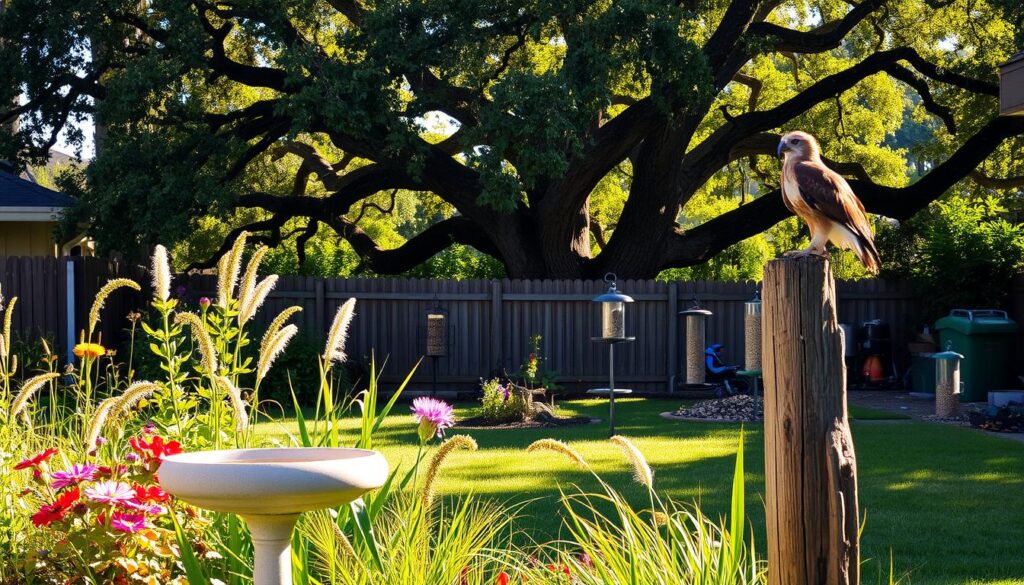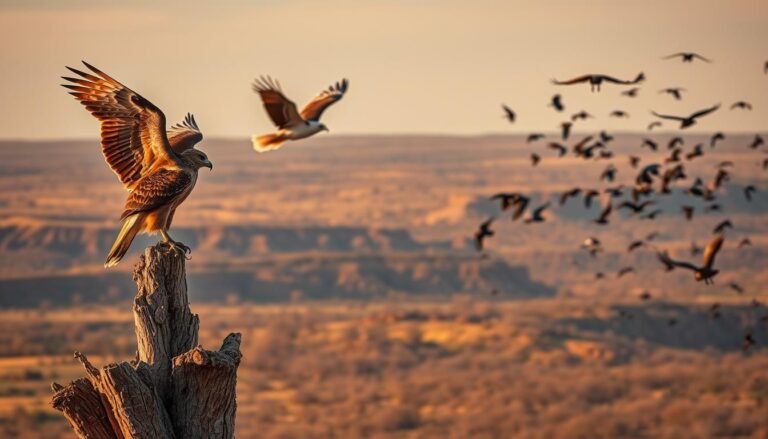Majestic Birds of Prey in Houston: I love watching birds, and Houston’s birds of prey are truly special. This city is a great place for eagles, hawks, and more, thanks to its perfect environment for raptors. Texas is home to over 660 bird species, including many birds of prey. In this article, I’ll talk about these amazing birds, show you which ones you can find in Houston, and explain why they’re important for nature. Let’s explore bird watching in Houston together and learn about efforts to save these incredible birds and their homes.
Birds of Prey in Houston: Key Takeaways
- Houston hosts a rich array of birds of prey with diverse species.
- Bird watching enthusiasts can witness unique raptors throughout Texas.
- Understanding the ecological role of these birds emphasizes their importance to the environment.
- Local conservation efforts contribute to the protection of birds of prey.
- Birds of prey have fascinating adaptations that enable them to thrive.
What Are Birds of Prey?
Birds of prey, or raptors, are crucial for ecosystems worldwide. They have unique traits that make them great hunters. Various species of Texas raptors help keep the balance in Houston and other places. Learning about these birds shows us their importance and the problems they deal with.
Defining Characteristics
Raptors are known by a few important features. They have strong, keen eyesight which lets them see prey from far away. Their sharp talons are perfect for catching and killing. Plus, their hooked beaks help them tear their food apart. These features let them hunt live prey, which is mostly what they eat.
Types of Birds of Prey
Texas is home to a wide array of birds of prey, showing off its rich wildlife. Some common ones are:
- Eagles – Known for their impressive size and strength.
- Hawks – Like the Red-tailed Hawk, often seen flying high.
- Falcons – For instance, the Peregrine Falcon, famous for its speed.
- Owls – Including the Great Horned Owl, which is mostly nocturnal.
Importance in the Ecosystem
Birds of prey play a vital role in their environments. They keep the numbers of small mammals and birds in check. This helps maintain ecological balance. Through this, raptors help control pests and support biodiversity. Learning about these roles lets us value their contributions more, especially in cities like Houston.
Common Birds of Prey Found in Houston
Houston is a great place for bird watchers. Here, I often see amazing birds that show what local birds are like. Some of these include the Red-tailed Hawk, Cooper’s Hawk, and Great Horned Owl. Each bird brings its own special traits and actions. This makes Houston’s bird scene very diverse.
Red-tailed Hawk
The Red-tailed Hawk is a well-known bird in North America. It has a big wingspan of 44.9 to 52.4 inches. You can find it flying over fields and woods. It’s quite big, measures 17.7 to 25.6 inches, and weighs 24.3 to 51.5 ounces. There are about 3.1 million of them in the U.S., growing at 1.3% per year. They lay 2 to 5 eggs and nest for 42 to 46 days. Their red tail is their trademark, making them popular among fans.
Cooper’s Hawk
The Cooper’s Hawk is known for its quick flying and distinct look. It’s a medium-sized hawk, 14.6 to 17.7 inches long, and weighs 7.8 to 24 ounces. It has a wingspan of 24.4 to 35.4 inches. This hawk likes wooded areas and hunts small birds and mammals. It lays 2 to 6 eggs which hatch in 30 to 36 days, and chicks stay in the nest for about 27 to 34 days. This bird offers a great chance for Houston birdwatchers to see something special.
Great Horned Owl
The Great Horned Owl is known for hunting at night. It has “horn” tufts that make it stand out. This owl is big, about 18.1 to 25.6 inches tall, with a wingspan of 39 to 57 inches. It weighs a lot, between 24.2 to 88.2 ounces, and can catch big prey. This owl is crucial for keeping rodents in check and is very important to the area. Its adaptability makes it a standout among Texas birds, offering unique sights for bird watchers here.
Where to Spot Birds of Prey in Houston
Houston is great for locations for birdwatching. You’ll find birds of prey in parks and reserves. Each place has unique habitats for these raptors. Exploring these areas has made me value Houston’s ecological diversity more.
Urban Parks
Places like Hermann Park and Memorial Park are awesome for seeing birds of prey. West 11th Street Park has 18 acres of woodlands. Here, you can often see Great Horned Owls and Eastern Screech Owls. These urban greenspaces are important for conservation.
Wildlife Reserves
Wildlife reserves are crucial for houston bird watching. Brazos Bend State Park is a highlight with its wetlands and grasslands. It draws birds like the Northern Harrier and Mississippi Kite. It’s a beautiful spot to watch raptors and get close to nature.
Nature Trails
The Houston Arboretum has trails full of birds all year. These paths go through different ecosystems. Here, seeing raptors fly above is common. Places like Sylvan Rodriguez Park have areas for prairie restoration. They’re great for spotting birds like the Red-Shouldered Hawk. These trails show why it’s key to protect natural spaces in cities.
| Location | Notable Birds of Prey | Habitat Features |
|---|---|---|
| Hermann Park | Fulvous Whistling Duck, Wood Duck | Central pond |
| West 11th Street Park | Great Horned Owl, Eastern Screech Owl | Woodland area |
| Brazos Bend State Park | Northern Harrier, Mississippi Kite | Wetlands and grasslands |
| Sylvan Rodriguez Park | Red-Shouldered Hawk | Prairie restoration area |
| Houston Arboretum | Variety of raptors | Diverse ecosystems |
Visiting these places helps me feel connected to nature and supports conservation. They help birdlife thrive and let the community enjoy and learn about bird sanctuaries houston.
Best Times for Birdwatching in Houston
Birdwatching in Houston is a year-round activity, each season offering unique chances to see different birds. Knowing when to watch birds can really make a difference. Each season has special migration trends, adding excitement to this activity.
Seasonal Patterns
In Houston, the best birdwatching happens in fall and spring. This is due to the migration of many bird species. During spring, you can see birds like the Red-tailed Hawk and Osprey. Hawk Mountain Sanctuary is a top place to watch these birds. Autumn brings a variety of migratory birds, thrilling for those who love birdwatching.
Time of Day
The best times for birdwatching are early morning and late afternoon. This is when raptors are most active, hunting and flying. Going out during these times often leads to exciting bird sightings.
Weather Conditions
Weather significantly influences birdwatching success. Clear skies improve visibility, making it easier to see birds. But, rain or storms mean birds are less visible, as they hide. For the best experience, choose days with clear weather.
Habitats of Birds of Prey in Houston
To really understand and love the birdlife in Houston, we must know about habitats of birds of prey. These exciting raptors live in different places in Houston that help them survive. They make their homes in forests, grasslands, and wetlands, which are all important for their life.
Forested Areas
Forests around Houston are where many birds, like the Great Horned Owl, make their nests. These places have lots of trees and room for the owls to live well. Trees help them find food and stay safe, which helps them survive better in these areas.
Grasslands
Bird habitats in Houston also include grasslands, which are open for birds to hunt. Red-tailed Hawks, for example, watch for prey in these wide spaces. These areas have plenty of small animals, making them perfect hunting grounds for these birds.
Wetlands
Wetlands are very important for birds like the Northern Harrier. In the marshes, they hunt small animals and birds. These wet areas in Houston are home to many creatures that birds eat and build nests in. The best time to see Northern Harriers is from October to April in these wetlands.
Conservation Efforts for Birds of Prey
Protecting birds of prey is key to keeping Texas’s ecological balance and diversity. Local groups lead these efforts, focusing on saving habitats and teaching people about these amazing birds.
Local Organizations
The Houston Audubon Society is vital in this mission. They work on restoring habitats and raising conservation awareness. The Blackland Prairie Raptor Center is unique in North Texas. It helps sick and injured birds get better. This center has a 66-acre area that helps local and migrating raptors and other animals.
Rehabilitation Programs
BPRC’s rehab programs help injured raptors heal and recover. These programs aid species like the Red-tailed Hawk and Bald Eagle. They show why it’s important to save birds of prey and their homes. Saving their habitats is crucial for their populations to survive and thrive.
Community Involvement
People’s involvement is critical for conservation to work. Volunteering lets people directly help improve the ecosystem and aid raptors. Public campaigns have shown that when communities get involved, they learn to value wildlife more. This motivates them to act in ways that benefit our environment.
| Organization | Focus Area | Notable Achievements |
|---|---|---|
| Houston Audubon Society | Habitat Restoration | Public Engagement and Education |
| Blackland Prairie Raptor Center | Rescue and Rehabilitation | Support for local and migratory species |
Educational Programs About Birds of Prey
In Houston, you can find many educational programs about birds of prey. They help people understand these amazing birds better. Through workshops, tours, or school events, our community learns more about raptor education.
Workshops and Seminars
“A Parliament of Owls” and “Get WILD with Raptors” are perfect for third to fifth graders. But, anyone can enjoy them. Each workshop is 45 minutes long, and talks about how to recognize these birds, where they live, and how we can protect them. Plus, it’s free to attend, which is great for everyone interested.
Here are some important dates to remember:
- Tuesday, January 29, 2025: 9:00 AM – 9:45 AM and 10:00 AM – 10:45 AM
- Wednesday, April 16, 2025: 9:00 AM – 9:45 AM and 10:00 AM – 10:45 AM
- Wednesday, February 19, 2025: 9:00 AM – 9:45 AM and 10:00 AM – 10:45 AM
- Wednesday, May 21, 2025: 9:00 AM – 9:45 AM and 10:00 AM – 10:45 AM
Guided Tours
Guided tours of wildlife reserves in Houston bring you closer to birds of prey. You get to see them in the wild while learning from experienced guides. These tours are hands-on educational programs birds of prey. They show the birds’ lifestyles and their importance in nature.
School Programs
The school programs are designed for grades 3-8 and high schoolers, following Texas’s education standards. They cover 24 different TEKS standards, ensuring a well-rounded education. These programs make learning about wildlife and conservation exciting for students who love nature.
| Program Name | Date | Time | Audience Level |
|---|---|---|---|
| A Parliament of Owls | January 29, 2025 | 9:00 AM – 10:45 AM | 3rd–5th Grade |
| A Parliament of Owls | April 16, 2025 | 9:00 AM – 10:45 AM | 3rd–5th Grade |
| Get WILD with Raptors | February 19, 2025 | 9:00 AM – 10:45 AM | 3rd–5th Grade |
| Get WILD with Raptors | May 21, 2025 | 9:00 AM – 10:45 AM | 3rd–5th Grade |
Photography Tips for Capturing Birds of Prey
As an avid enthusiast of bird photography, I’ve learned it takes the right gear and knowing how birds act. With helpful bird photography tips, you can capture those mesmerizing moments. Let’s talk about the gear, techniques, and how to be ethical while taking photos of birds.
Best Equipment to Use
A good camera is key for taking photos of birds. I suggest a DSLR like the Nikon D500. It takes 10 pictures a second, perfect for action shots. For lenses, though some can be quite expensive, there are budget-friendly choices. The Sigma 150-600mm f/5-6.3 and the Tamron SP 150-600mm f/5-6.3 are less than $1,500. Let’s look at some popular photography gear:
| Equipment | Features | Approximate Price |
|---|---|---|
| Nikon D500 | 10 fps, APS-C sensor | $1,800 |
| Nikon D810 | 5 fps, full-frame sensor | $2,700 |
| Sigma 150-600mm f/5-6.3 | Lightweight, versatile | $1,000 |
| Tamron SP 150-600mm f/5-6.3 | Stable and sharp images | $1,200 |
| Canon 500mm f/4 | High-quality, though heavier | $8,000+ |
Techniques for Successful Shots
There are a few techniques I use to improve my bird photos. Use at least 1/2000 second shutter speed for flying birds. Knowing when to use burst mode is key, like shooting a Tricolored Heron catching its prey. Learning about bird behavior is also important. For instance, a Great Blue Heron may stay still, but Pied-billed Grebes move a lot. Using auto ISO helps keep the shutter speed the same in different light.
Ethical Considerations
Ethical practices in wildlife photography are very important to me. It’s key to respect birds’ space and not disturb them, especially during nesting or hunting season. I make sure to keep a safe distance, letting these magnificent raptors live stress-free in their natural habitat.
How to Attract Birds of Prey to Your Yard

Making a space to attract birds of prey in Houston needs careful planning. By creating the right environment, majestic raptors could visit more often. This part talks about how to make your yard welcoming for them.
Creating a Suitable Habitat
Using native plants is key to making good habitats for birds. These plants offer shelter and places to nest for birds, including raptors. Tall grasses pull in small animals, which are important food for birds of prey.
Letting parts of your yard stay wild increases backyard biodiversity. This makes it a better place for hawks and owls.
Providing Food Sources
Having bird feeders with seeds attracts small birds, which then bring in birds of prey. Creating spaces for small animals helps, too. This way, you help local wildlife and draw in raptors.
Knowing what different raptors eat helps you offer the right food.
Minimizing Disturbances
It’s crucial to keep pets inside during early morning and dusk. This is when birds of prey are most active. Reducing noise and human activity makes it likelier for them to visit.
Challenges Faced by Birds of Prey in Houston
Birds of prey in Houston face tough challenges due to growing cities. Their living spaces and places to find food are being taken over by buildings and roads. This means they have less room to live and more competition for food.
Urbanization Impact
As Houston grows, the homes of these birds shrink. Where there were once forests and wetlands, now there are houses and stores. Without enough places to hunt, birds of prey have a hard time finding food.
Pollution Concerns
Pollution is a big problem for these birds. Things like pesticides and metals get into their homes and make them sick. When birds eat contaminated food, it can hurt their ability to have babies and cause more of them to die young.
Climate Change Effects
Climate change makes life even harder for birds of prey in Houston. Weird weather can mess up their travel plans and when they have babies. It can also make it tough to find food when they really need it. These birds need to quickly adjust to all these changes to survive.
Fun Facts About Birds of Prey
Birds of prey are incredible, with unique ways to be excellent hunters. They can see their prey from far away. For example, the Peregrine Falcon can dive at speeds over 200 mph. Also, the Cooper’s Hawk lives well in cities, showing how they can adapt.
Unique Adaptations
These birds have special behaviors that help them survive. Some, like the Merlins, do fancy flights to find a mate and claim their space. They also make sounds to talk to each other, keeping their area safe. This helps them connect with their partner and protect their home.
Cultural Significance
Birds of prey have been important in many cultures, symbolizing strength and freedom. They’ve been part of stories and art for thousands of years. Knowing about their role in culture helps us appreciate and protect them. This way, future generations can also enjoy these amazing birds.
FAQ
What types of birds of prey can I see in Houston?
Where are the best places for bird watching in Houston?
When is the best time to watch birds of prey in Houston?
How can I attract birds of prey to my yard?
What conservation efforts exist for birds of prey in Houston?
Are there educational programs about birds of prey in Houston?
What challenges do birds of prey face in Houston?
References
| Source Name | URL |
| International Association for Falconry and Conservation of Birds of Prey (IAF) | https://conservationportal.sycl.net/1/falconry-and-conservation |
| Raptor Research Foundation (RRF) | https://raptorresearchfoundation.org/about/ |
| Bird of Prey – Wikipedia | https://en.wikipedia.org/wiki/Bird_of_prey |
| Hawk Mountain Sanctuary | https://www.hawkmountain.org/about/community/our-global-partners |
| Bird of Prey Project | https://birdofpreyproject.org/about-us/ |







